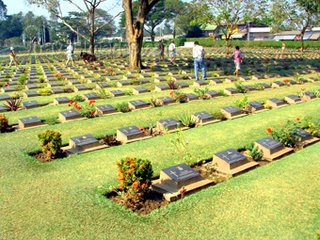Kanjanaburi: Graves - War Cemetery in Thailand
Thailand Travel Kanchanaburi, Thailand (AP) -- Rod Beattie sweeps a metal detector over a watermelon field along the River Kwai where six decades ago 2,000 Allied prisoners of war perished. The detector buzzes, and the wiry Australian anxiously claws the earth with his bare hands.
This is just brilliant
" he says, breaking up a clod of soil to reveal a brass badge, a neat likeness of a propeller airplane perhaps crafted by a captured airman longing for the free, blue skies.Graves - War Cemetery in Thailand
Sweating under the tropical sun, the 54-year-old Australian places the find alongside razors, toothbrushes and belt buckles, surmising these may have been items cremated with prisoners who succumbed to cholera and other diseases at the Chungkai hospital camp.Graves - War Cemetery in Thailand
 The fruit of this morning's excavation is headed for a bulging repository of artifacts from the Death Railway, which spelled the deaths of some 100,000 Allied POWs and Asian slave laborers forced to build a line between Thailand and Myanmar for the Japanese army during World War II.
The fruit of this morning's excavation is headed for a bulging repository of artifacts from the Death Railway, which spelled the deaths of some 100,000 Allied POWs and Asian slave laborers forced to build a line between Thailand and Myanmar for the Japanese army during World War II.the best of these items
Beattie explains, may find their way into displays of the Thailand-Burma Railway Center, a world-class museum recently opened after four years of painstaking effort by Beattie and several colleagues passionate about telling the story minus the myths and misinformation.Graves - War Cemetery in Thailand Travel
Until then, Kanchanaburi was poorly served by two small, rather shabby museums and Thai tourist guides who often pass on meager, or outright, fictitious stories. This despite an industry built around the railway, bridge and river which have attracted millions of tourists and piles of cash since Hollywood released its classic film "The Bridge on the River Kwai" in 1957.Thailand Travel The Bridge on the River Kwai
Beattie says he strived for an unbiased presentation through information panels, photographs, artifacts, video clips and an interactive, detailed topographical map of the 258-mile railway, its stations and POW camps. The collection includes rare Japanese photographs provided by Ranichi Sugano, believed to be the last surviving senior engineer from the railway.The museum doesn't stint on displays of Japanese cruelty
depicting POWs turned into walking skeletons while hacking through disease-ridden jungles under their captors' guns. But neither does it portray all Japanese soldiers as brutes nor their railway engineers as blustering incompetents.This place will never be finished
Conditions varied from camp to camp, Japanese soldiers were also subjected to harsh punishment from their officers and some POWs developed decent relations with their guards. Beattie points out that a third of the 10,000 Japanese prisoners under British control in post-war Singapore perished, whereas less than 23 percent of British POWs on the railway died.The museum has drawn praise from both Japanese visitors and former POWs
"Bloody brilliant," wrote John Reid, of Brisbane, Australia, in the guest book). And even those far too young to remember the war are moved by the displays and a view from the museum's second floor: 6,982 crosses of the Kanchanaburi War Cemetery.This place will never be finished
It's organic. As I find and discover more things we'll have more to explain and exhibit," says Beattie, a civil engineer from Gympie, Queensland, who became deeply involved with this slice of history in 1994 when he was consulting for a sapphire mining company in Kanchanaburi.The Bridge on the River Kwai museum
He was later appointed caretaker of the area's two cemeteries by the Commonwealth War Graves Commission. A third POW burial ground is located in Myanmar, also known as Burma. Before the advent of the museum, which opened in January, Beattie had logged some 1,240 miles on foot mapping the railway, clearing sections of the invading jungle and collecting artifacts. Beattie, who funded a large chunk of the museum's costs from his own pocket, says he's prepared to borrow against his successful gem-cutting business to keep it going.Source : Sawatdee


































2 Comments:
Thank for comment
Thank you, Rod, for helping make "Secrets of the Dead" come alive. My (English) father, Finlay Mungall, was a prisoner on the River Kwai. After leaving England for the US I worked for a Mobil Engineer (an American) who had bombed the same bridge! Small world. I look forward to visiting your museum and the railway some time.
My dad was a splendidly happy-go-lucky person -- as were all his POW friends who I had the good fortune to meet. It must have been a survival trait.
Thanks again, Chris.
PS Your making the unfortunate Mr. Altabba carry the stone up the embankment made the show.
Post a Comment
<< Home